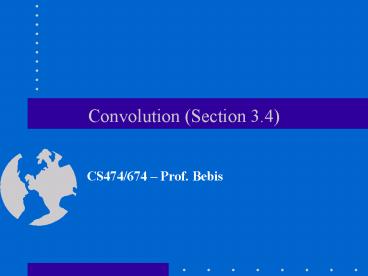Convolution (Section 3.4) PowerPoint PPT Presentation
Title: Convolution (Section 3.4)
1
Convolution (Section 3.4)
- CS474/674 Prof. Bebis
2
Correlation - Review
K x K
3
Convolution - Review
- Same as correlation except that the mask is
flipped both horizontally and vertically. - Note that if w(x,y) is symmetric, that is
w(x,y)w(-x,-y), then convolution is equivalent
to correlation!
4
1D Continuous Convolution - Definition
- Convolution is defined as follows
- Convolution is commutative
5
Example
- Suppose we want to compute the convolution of the
following two functions
6
Example (contd)
7
Example (contd)
Step 3
8
Example (contd)
9
Example (contd)
10
Example (contd)
11
Example (contd)
12
Example (contd)
13
Example (contd)
14
Important Observations
- The extent of f(x) g(x) is equal to the extent
of f(x) plus the extent of g(x) - For every x, the limits of the integral are
determined as follows - Lower limit MAX (left limit of f(x), left limit
of g(x-a)) - Upper limit MIN (right limit of f(x), right
limit of g(x-a))
15
Example (contd)
16
Example
17
Convolution with an impulse (i.e., delta
function)
18
Convolution with an train of impulses
19
Convolution Theorem
- Convolution in the time domain is equivalent to
multiplication in the frequency domain. - Multiplication in the time domain is equivalent
to convolution in the frequency domain.
f(x) F(u) g(x) G(u)
20
Efficient computation of (f g)
- 1. Compute and
- 2. Multiply them
- 3. Compute the inverse FT
21
Discrete Convolution
- Replace integral with summation
- Integration variable becomes an index.
- Displacements take place in discrete increments
22
Discrete Convolution (contd)
5 samples
3 samples
g - 1)
23
Convolution Theorem in Discrete Case
- Input sequences
- Length of output sequence
- Extended input sequences (i.e., pad with zeroes)
24
Convolution Theorem in Discrete Case (contd)
- When dealing with discrete sequences, the
convolution theorem holds true for the extended
sequences only, i.e.,
25
Why?
continuous case
discrete case
Using DFT, it will be a periodic function with
period M (since DFT is periodic)
26
Why? (contd)
If MltAB-1, the periods will overlap
If MgtAB-1, the periods will not
overlap
27
2D Convolution
- Definition
- 2D convolution theorem
28
Discrete 2D convolution
- Suppose f(x,y) and g(x,y) are images of size
- A x B and C x D
- The size of f(x,y) g(x,y) would be N x M where
- NAC-1 and MBD-1
- Extended images (i.e., pad with zeroes)
29
Discrete 2D convolution (contd)
- The convolution theorem holds true for the
extended images.

